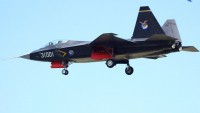New Training Regime for Chinese Jet Fighter Pilots Aims to get Them to Think
| Arthur Dominic Villasanta | | Nov 12, 2016 09:25 PM EST |
(Photo : PLAAF) PLAAF fighter pilots march like soldiers.
Training that still emphasizes blind obedience to the commands of their ground controllers means today's young fighter pilots of the People's Liberation Army Air Force (PLAAF) aren't going to last very long in combat against the maverick fighter pilots of the United States Armed Forces trained to value initiative, aggressiveness and an intense desire to destroy the enemy.
Like Us on Facebook
Think of Tom Cruise as Lt. Pete "Maverick" Mitchell in the 1986 Hollywood hit movie "Top Gun" to picture today's U.S. fighter pilot. Think of an unmanned combat aerial vehicle (UCAV) when you picture today's PLAAF fighter pilots.
The UCAV analogy is apt because this machine will only do what its operators (normally two pilots in a ground control station) tell it to do. A UCAV can't think. It can only react. Much like a PLAAF fighter pilot that has to ask permission from his ground control before he does anything.
News the PLAAF wants its fighter jocks to fight more like traditional fighter jocks suggests the PLAAF can overcome its six decades of addiction to ground control, and almost overnight transform its army of zombie fighter pilots into actual thinking machines. Good luck with that.
A report by American global policy think tank RAND Corporation claims a new PLAAF fighter pilot training regime will focus on "actual combat conditions ... manifested in training scenarios meant to mimic or simulate real-world battle conditions."
This new training doctrine will include an emphasis on "free air combat" and "unscripted scenarios," phrases meaning initiative and quick thinking as alien to the PLAAF as mom's apple pie.
The qualities, which continue to receive emphasis at the U.S. Air Force's and U. S.Navy's fighter weapons schools, are a reason American fighter pilots are dominant in air-to-air combats, which the public still equates with the mano-a-mano dogfights of the Second World War where getting on the other guy's "six o'clock" was the overriding aim.
The RAND's report saw PLAAF "shortfalls in pilot performance, including insufficient flight-lead skills and autonomy, lax discipline during daily training, poor tactics, and a lack of coordination with other PLAAF branches."
PLAAF's fighter jocks have their work cut out when they finally face their U.S. foes over the South China Sea beyond the reach of their ground control.
TagsPeople's Liberation Army Air Force, fighter pilots, Tom Cruise, Lt. Pete "Maverick" Mitchell, Top Gun, unmanned combat aerial vehicle, UCAV
©2015 Chinatopix All rights reserved. Do not reproduce without permission
EDITOR'S PICKS
-

Did the Trump administration just announce plans for a trade war with ‘hostile’ China and Russia?
-

US Senate passes Taiwan travel bill slammed by China
-

As Yan Sihong’s family grieves, here are other Chinese students who went missing abroad. Some have never been found
-

Beijing blasts Western critics who ‘smear China’ with the term sharp power
-

China Envoy Seeks to Defuse Tensions With U.S. as a Trade War Brews
-

Singapore's Deputy PM Provides Bitcoin Vote of Confidence Amid China's Blanket Bans
-

China warns investors over risks in overseas virtual currency trading
-

Chinese government most trustworthy: survey
-

Kashima Antlers On Course For Back-To-Back Titles
MOST POPULAR
LATEST NEWS
Zhou Yongkang: China's Former Security Chief Sentenced to Life in Prison

China's former Chief of the Ministry of Public Security, Zhou Yongkang, has been given a life sentence after he was found guilty of abusing his office, bribery and deliberately ... Full Article
TRENDING STORY

China Pork Prices Expected to Stabilize As The Supplies Recover

Elephone P9000 Smartphone is now on Sale on Amazon India

There's a Big Chance Cliffhangers Won't Still Be Resolved When Grey's Anatomy Season 13 Returns

Supreme Court Ruled on Samsung vs Apple Dispute for Patent Infringement

Microsoft Surface Pro 5 Rumors and Release Date: What is the Latest?












